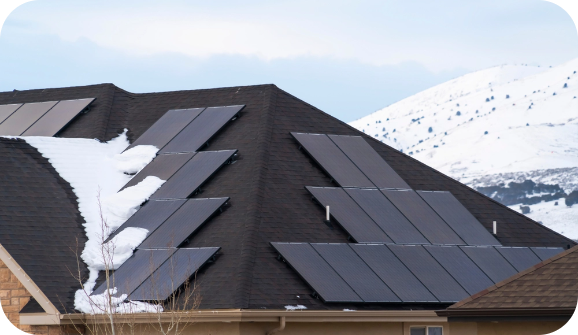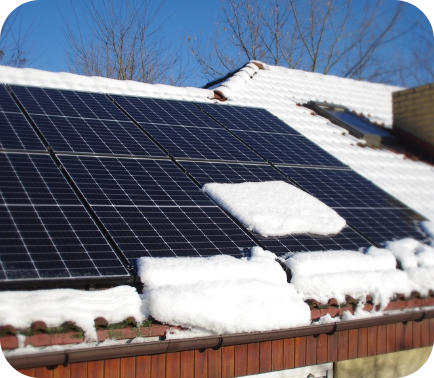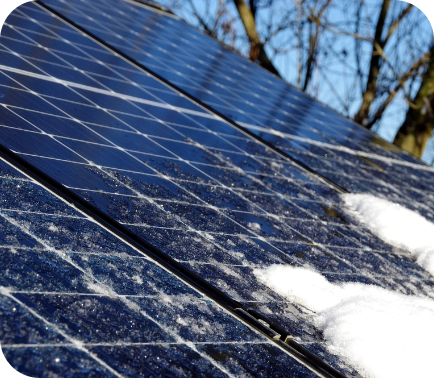Will Solar Panels Work in the Snow?
Solar panels are a great way to reduce your dependence on the electrical grid and minimize your energy bills. But how do solar panels work? Simply put, solar panels convert the sun’s light into energy used to power your home — which is great during summer when the sun is shining bright, but what about winter when the snow flies and covers up your panels? Do solar panels work with snow on them?

If part of your electricity needs depends on the energy generated from solar panels, you may worry about them working throughout cloudy days and the winter months. Let’s consider how your panels will fare during those cold winter months and what you need to do to keep solar panels in snow working efficiently (if anything at all).
Do Solar Panels Work in the Winter?
To answer this question, yes — solar panels work in the winter! The panels work by absorbing the sun’s light, not its heat, so there isn’t a need to worry about panels not working during those icy cold winter months. However, they may produce less energy in winter than in the summer.

Why Do Panels Generate Less Energy in the Winter?
The reason solar panels generate more energy during the summer months isn’t about the temperature; it’s about the daylight available in the summer versus winter months. Your solar panels produce less energy during the winter because the days are shorter and, of course, due to snow. The amount of snow — and whether it’s day or night — will determine the length of time your panels may generate less energy.
Other factors, such as the angle and tilt of the panels, snow cover, and overall weather conditions, also play a role in the reduced energy output during winter. The amount of snow and its coverage on the panels can impact the length of time panels generate less energy. It’s worth noting that snow cover can be temporary, and panels may resume normal energy production once the snow melts or is removed.
How Do Solar Panels Function in Snow?
Solar panel technology is designed to capture sunlight and convert it into electricity through the photovoltaic (PV) effect. It’s important to note that PV cells are primarily concerned with capturing photons, not heat. Therefore, solar panels in winter can still produce electricity at a reduced capacity.


Is Winter Solar Panel Maintenance Necessary?
As we’ve discussed, the way solar panels are designed necessitates minimal panel maintenance. However, winter brings its own challenges for solar panel owners, and regular inspection can help you identify snow buildup, ice formation, or debris accumulation on your panels. Gentle brushing or using a snow rake designed for solar panels can help you remove snow without causing damage.
It’s also important to keep your panels clean to maximize sunlight absorption, as dirt and grime can reduce efficiency. Additionally, monitoring the tilt and orientation of the panels and adjusting them as needed can help with snow shedding and maximize energy production.
Preventing Snow Buildup
We’ve heard it asked, “Do solar panels work through snow?” While snow doesn’t render solar panels useless by any means, it can decrease your panel efficiency, so you should take precautions to minimize snow buildup and maximize energy production during the winter months. Here are a few measures to take:
Panel Tilt and Orientation
To ensure that your solar panels easily shed snow, adjust their tilt and orientation. When panels are angled correctly, snow can slide off effortlessly. A qualified solar installer can help you determine the best way to position your panels for these purposes in a cold climate.
Clearing Snow
If you experience substantial snow accumulation, it may be necessary to manually clear the snow from your panels. This can be done using a soft bristle brush or a snow rake designed specifically for solar panels. Consult with a professional to ensure you have the right tool for the job.
Snow Retention Systems
Snow retention systems create small barriers and interrupt the smooth flow of snow, causing it to accumulate in smaller amounts or gradually melt away. By keeping the snow distributed evenly across the panel surface, the system maintains a consistent level of efficiency during snowy conditions. It minimizes the risk of snow buildup, ensuring consistent electricity generation and reducing the need for frequent manual snow removal.
Ready to Electrify Your Life?
Solar panels and snow can go together. If you live in a region with snowy winters, don’t let the fear of snow deter you from considering solar panels. Consult with a reputable solar installation company that can provide guidance on proper panel tilt, orientation, and maintenance during snowy months. Axia is here to help make the transition easy and seamless. Contact one of our expert solar advisors today for a quote in your area.